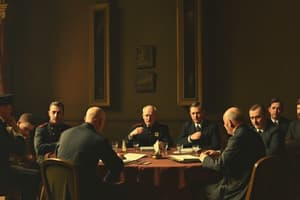Podcast
Questions and Answers
What does Article 231 of the Treaty of Versailles require Germany to do?
What does Article 231 of the Treaty of Versailles require Germany to do?
- Accept responsibility for the war (correct)
- Dismantle its military forces
- Pay reparations to the Allied Powers
- Forgive the Allies for wartime actions
Which leader was associated with the Treaty of Versailles from the United States?
Which leader was associated with the Treaty of Versailles from the United States?
- Francois Mitterrand
- Lloyd George
- Woodrow Wilson (correct)
- Georges Clemenceau
What major impact did the Treaty of Versailles have on Germany?
What major impact did the Treaty of Versailles have on Germany?
- It allowed them to expand their territories
- It increased their international alliances
- It imposed military restrictions (correct)
- It required them to support fascist regimes
Which of the following nations was NOT formed as a result of the dissolution of Austria-Hungary?
Which of the following nations was NOT formed as a result of the dissolution of Austria-Hungary?
What type of political ideology was characterized by the rejection of extreme racism in Italy?
What type of political ideology was characterized by the rejection of extreme racism in Italy?
Who was the British leader during the negotiations of the Treaty of Versailles?
Who was the British leader during the negotiations of the Treaty of Versailles?
Article 232 of the Treaty of Versailles placed blame solely on Germany.
Article 232 of the Treaty of Versailles placed blame solely on Germany.
List one country that emerged from the dissolution of Austria-Hungary.
List one country that emerged from the dissolution of Austria-Hungary.
The political ideology characterized by protection of Jews in Italy was called __________.
The political ideology characterized by protection of Jews in Italy was called __________.
Match the leaders with their respective countries:
Match the leaders with their respective countries:
Flashcards
Treaty of Versailles
Treaty of Versailles
The peace treaty that officially ended World War I, imposing harsh terms on Germany.
War Guilt Clause (Article 231)
War Guilt Clause (Article 231)
Forced Germany to accept sole responsibility for starting World War I, leading to reparations.
Reparations (Article 232)
Reparations (Article 232)
Germany's financial obligations to compensate Allied nations for war damages.
Woodrow Wilson (US)
Woodrow Wilson (US)
Signup and view all the flashcards
Georges Clemenceau (France)
Georges Clemenceau (France)
Signup and view all the flashcards
Why did the Treaty of Versailles fail?
Why did the Treaty of Versailles fail?
Signup and view all the flashcards
Who were the 'Big Three'?
Who were the 'Big Three'?
Signup and view all the flashcards
What was the 'War Guilt Clause'?
What was the 'War Guilt Clause'?
Signup and view all the flashcards
What were 'Reparations'?
What were 'Reparations'?
Signup and view all the flashcards
How did Austria-Hungary change after World War I?
How did Austria-Hungary change after World War I?
Signup and view all the flashcards
Study Notes
The Treaty of Versailles
- Almost five years after Archduke Ferdinand's assassination, world leaders met at Versailles to sign a peace treaty.
- Thirty-two victorious countries, including Canada, were represented.
- Canada wanted separate representation, arguing for a voice in peace talks due to its wartime contributions.
- The main decisions were made by Britain, France, and the US (the Big Three).
- Germany, the defeated nation, was not invited to the peace talks.
Woodrow Wilson
- Woodrow Wilson, the US president, aimed for a fair settlement to prevent future conflicts.
- He proposed the Fourteen Points, advocating for disarmament, free trade, and a League of Nations.
- The League of Nations was intended to resolve future disputes internationally.
Georges Clemenceau
- Georges Clemenceau, the French leader, was determined to punish Germany for the war.
- He wanted Germany severely weakened to prevent future attacks on France.
- He sought reparations from Germany for starting the war and resulting damages.
- He also wanted Germany's army disbanded.
Other Key Issues
- The Treaty of Versailles included Article 231 (War Guilt Clause), holding Germany responsible for war damages.
- Article 232 imposed reparations on Germany for war damages to the Allied Powers.
- New countries were created in Europe after the war, including: Poland, Austria, Hungary, Czechoslovakia, and Yugoslavia.
- This territory was transferred to different countries.
- The creation of the Polish Corridor led to significant tensions with Germany.
- Self-determination was a key principle recognized after the war. Meaning every nation had the right to its own state.
Studying That Suits You
Use AI to generate personalized quizzes and flashcards to suit your learning preferences.




